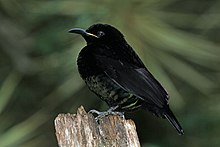Ptiloris
[1][2] These birds of paradise are commonly known as riflebirds, so named for the likeness of their black velvety plumage to the uniform of the Rifle Brigade.
[3] Alternatively, the bird's cry is similar to a rifle being fired and hitting its target[3] but a call like this is not commonly reported (see Behaviour and Ecology).
[2][4] The genus Ptiloris was introduced in 1825 by the English naturalist William Swainson for a single species, the paradise riflebird.
[8] Riflebirds are stocky medium-sized passerines with a small head and a characteristic long slender decurved bill.
[2][11][12] Adult male riflebirds of the four species are similar in appearance: all are entirely velvety black with lighter underparts, iridescence on the head, upper throat and centre of the tail, and yellow mouth and gape.
[2][4] Males of the magnificent and growling riflebirds have more prominent grey-black underparts, black and yellow bands across their mid-breast, and long thin curved plumes from the lower flanks that extend to the end of the tail in P. magnifica or just short in P.
[2][4] Adult female riflebirds of the four species are also similar in appearance: all are largely brown above, have a prominent cream supercilium, and are whitish to buff with dark markings underneath.
[2][13] They climb up and down tree trunks and hop along horizontal branches searching for insects and their larvae, which they extract from under the bark, in crevices, and epiphytes using their chisel-like bills.
[13] Only one reference has been made to riflebirds (P. magnifica) as a seed disperser of rainforest plants including Ficus spp.
[13] Nestlings have been reported as being fed crickets, grasshoppers, spiders, cockroaches, centipedes, cicadas, woodlice, beetles, and insect larvae.
[13] Like most other birds of paradise, riflebirds are polygynous, with promiscuous males displaying to and mating with several different females.
[2][13] During the breeding season, male Victoria's riflebirds have been reported to have home ranges of 0.6 to 2.8 ha, containing up to 5 display posts.
[13] Male riflebirds appear to rigidly follow a progression of vocalisations, postures, and movements when displaying to females.
[12] At this stage, male magnificent and growling riflebirds may start hopping sideways along the display branch.
[12] A female riflebird signals her receptiveness by briefly fluttering her wings and the male hops onto her back before copulation.
[17][18][19] The population trends for P. paradisea and victoriae are reported as declining but not approaching the threshold for vulnerable status.

